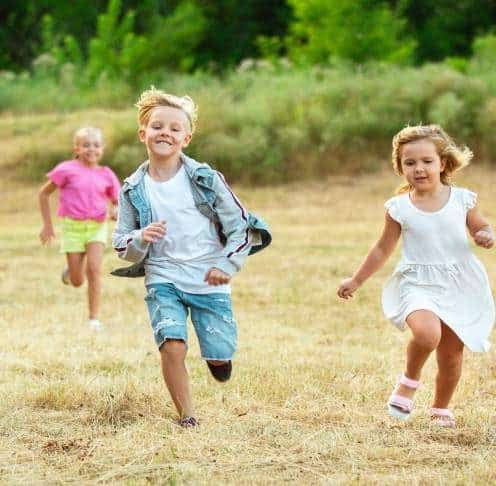
Research Study: What factors are associated with outdoor time among children speaking a non-official language at home?
Thank you for Dr. Richard Larouche, Assistant Professor of Public Health at the University of Lethbridge, and Dr. Ransi Nayakarathna, MSc student in Health Sciences at the University of Lethbridge, for providing this post.
As discussed in the Position Statement on Active Outdoor Play (Tremblay et al., 2015), children who spend more time outside are more physically active overall. This finding is so consistent that, in a systematic review, Gray and colleagues (2015) could not find a single published article that did not show a significant association between outdoor time and physical activity!
In 2019, we published an article about the factors associated with physical activity among 1,699 children recruited in schools located in urban, suburban, and rural areas within the regions of Ottawa (Ontario), Trois-Rivières (Québec), and Vancouver (British Columbia) (Larouche et al., 2019). We again found that boys and girls who spent more time outdoors were more physically active. Other factors associated with physical activity differed markedly by gender. An interesting finding was that girls who spoke a non-official language at home were significantly less active than girls who spoke English or French at home.
That 2019 article provided a foundation for a new Master’s thesis; Ransi Nayakarathna examined the factors associated with physical activity and outdoor time among the 478 children who spoke a non-official language at home (Nayakarathna, 2021). Findings from this thesis have been recently published in the Journal of Physical Activity & Health (Nayakarathna et al., 2022) where the Editor of the journal selected this article to be accessible free of charge in December 2022. Our article used the social-ecological model (Bauman et al., 2012) which posits that behaviours are influenced by a wide range of factors at multiple levels, including the individual (child), interpersonal (e.g., parent and peers), community (e.g., school), policy, and the built and natural environment (e.g., access to parks, weather).
In this article, we found that factors associated with outdoor time varied markedly between boys and girls (see image below). Girls spent 12 less minutes/day outdoors than boys and their outdoor time was mostly associated with characteristics and perceptions of their parents. For instance, lower parental education (high school or less) was associated with less outdoor time in girls. In addition, girls whose parents were less concerned about neighbourhood safety and social cohesion (e.g., parents felt that other adults in the neighbourhood looked out for children) spent more time outside.

A broader variety of factors were associated with boys’ outdoor time. Boys who had more freedom to explore their neighbourhood without adult supervision (i.e., independent mobility) spent more time outdoors. Boys who owned a mobile phone also spent more time outdoors. Although this finding seems odd at first glance, parents may provide a phone to their children as they gain more independent mobility, so they can stay in touch (Riazi et al., 2019).
We found that boys with older parents and/or parents who biked to work also spent more time outdoors. Boys living in urban areas (compared to suburban areas) also spent more time outdoors. Finally, we unsurprisingly found that boys spent more time outdoors when the outdoor temperature was warmer.
Collectively, our findings suggest that interventions aiming to increase outdoor time among children speaking non-official languages at home should consider gender differences in factors associated with outdoor time. In other words, different strategies may be needed to encourage boys and girls to spend more time outdoors.
Consistent with the social-ecological model, we found that the factors associated with boys’ outdoor time included characteristics of the child, parent, as well as the built and natural environment. If our results are confirmed by future studies, this would suggest that interventions to promote outdoor time should target multiple levels of the social-ecological model.
Finally, it is worth noting that our study focused on language spoken at home, which is one indicator of acculturation (the process by which people acquire the culture of a particular society). Future research should examine other factors associated with acculturation such as immigrant generation (e.g., first, second, and third generation immigrants), time since immigration, and cultural practices.
It is also worth noting that the Outdoor Play in Canada: 2021 State of the Sector Report (Outdoor Play Canada, 2021) emphasized the need for more work on outdoor play with minority populations as a priority area. Our paper can be used to inform work on this priority area and highlights how populations who speak non-official languages at home are an important subpopulation to support in promoting outdoor play.
Richard was recently interviewed by Dr. David R. Bassett (Associate Editor of the journal) on the findings of this paper. You can watch that interview on Youtube, here.
Richard Larouche is an Associate Professor at the University of Lethbridge and Chair of the graduate Public Health programs. He is a Board member of Outdoor Play Canada. His research focuses on topics related to healthy active living and sustainability.
Ransi Nayakarathna is currently working as a Research Associate at the Medlior Health Outcomes Research. She is starting her PhD at the University of Lethbridge in Fall, 2023. Her research interests are on physical activity & health in the immigrant population.
References
Bauman, A. E., Reis, R. S., Sallis, J. F., Wells, J. C., Loos, R. J., Martin, B. W., & Lancet Physical Activity Series Working Group. (2012). Correlates of physical activity: why are some people physically active and others not? The Lancet, 380(9838), 258-271.
Gray, C., Gibbons, R., Larouche, R., Sandseter, E. B. H., Bienenstock, A., Brussoni, M., … & Tremblay, M. S. (2015). What is the relationship between outdoor time and physical activity, sedentary behaviour, and physical fitness in children? A systematic review. International Journal of Environmental Research and Public Health, 12(6), 6455-6474.
Larouche, R., Blanchette, S., Faulkner, G., Riazi, N., Trudeau, F., & Tremblay, M. S. (2019). Correlates of Children’s Physical Activity: A Canadian Multisite Study. Medicine and Science in Sports and Exercise, 51(12), 2482-2490.
Nayakarathna R. Correlates of Physical Activity and Outdoor Time in Canadian School Children From Families Speaking a Non-Official Language at Home [Master’s thesis]. University of Lethbridge; 2021. https://hdl.handle.net/10133/6129
Nayakarathna, R., Patel, N. B., Currie, C., Faulkner, G., Riazi, N. A., Tremblay, M. S., … & Larouche, R. (2022). Correlates of Outdoor Time in Schoolchildren From Families Speaking Nonofficial Languages at Home: A Multisite Canadian Study. Journal of Physical Activity and Health, 19(12), 828-836.
Outdoor Play Canada (2021). Outdoor Play in Canada (2021) State of the Sector Report. Available from: https://www.outdoorplaycanada.ca/wp-content/uploads/2021/09/OPC_SSR_english_FINAL.pdf
Riazi, N. A., Blanchette, S., Trudeau, F., Larouche, R., Tremblay, M. S., & Faulkner, G. (2019). Correlates of children’s independent mobility in Canada: a multi-site study. International Journal of Environmental Research and Public Health, 16(16), 2862.
Tremblay, M. S., Gray, C., Babcock, S., Barnes, J., Costas Bradstreet, C., Carr, D., … & Brussoni, M. (2015). Position statement on active outdoor play. International Journal of Environmental Research and Public Health, 12(6), 6475-6505.

